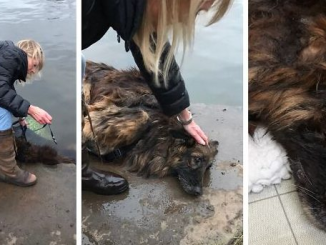The two-year-old dog became lethargic, thin and listless, deteriorating to the point that it was admitted to a pet hospital for a week for a blood transfusion.
“I was really worried about him,” Ms Powell, an enrolled nurse, said.
Testing confirmed Leo had ehrlichiosis, a disease transmitted through bites from brown dog ticks carrying the Ehrlichia canis bacteria.
But what worried the specialists is that Leo lives in the urban Top End, which some experts fear is becoming a new stronghold for a disease spreading like wildfire.
The first Australian case was detected in the Kimberley region of Western Australia in May last year.
By June, cases were rapidly emerging in Katherine in the Northern Territory and the surrounding remote communities.
The Northern Territory government has recorded 370 confirmed cases — 110 in the Darwin and Arnhem Land region, 149 in the Katherine region, 36 in Tennant Creek and in Alice Springs and surrounds, 75.
Experts say countless more have been left undetected in remote communities with little intervention.
“When we finally got to bring him home, [the vets] said he needs to stay inside, he’s at risk of spontaneous bleeding and he might not make it,” Ms Powell said.
“It was very full-on, very emotional.
“There were tears basically every night.”
Until the first cases were discovered just last year, stringent biosecurity controls had kept ehrlichiosis out of Australia.
Experts are still baffled by how the disease got in but, according to Professor Peter Irwin from the School of Veterinary Medicine at Murdoch University, the disease is now considered “endemic” across the NT.
“Ehrlichiosis is one of the most serious diseases of dogs in my opinion,” he said.
“It makes them very ill, and many dogs can die.
“Once it establishes into a tick population, it’s very difficult to eradicate.”

Common symptoms include lethargy, fever and cloudy eyes, which can be cleared up with antibiotics but, if left untreated, the disease can lead to blindness, uncontrollable bleeding and death.
“The problem with this disease is that dogs travel and spread infected ticks,” Professor Irwin said.
“Dogs that have moved from an endemic area of the community into the city will possibly bring ticks with them, and the ticks can then drop off.
“There have now been dogs with the disease identified in most other capitals, most as a result of travel from the north.”
Doctor Stephen Cutter, the head veterinarian at Darwin’s Ark Animal Hospital, is no stranger to the crippling disease.
He said up to 40 per cent of the dogs are infected in the remote communities of the Top End he visits on rotation.
But in August of last year, he saw his first case in a pet that had not left urban Darwin.
Arielle Giles, a vet at the Darwin Veterinary Hospital, confirmed the disease’s spread to Darwin, saying she had seen six cases in the past three months.
“It’s a devastatingly bad disease and it’s really difficult to treat,” Dr Cutter said.
“It’s basically everywhere and it’s now a matter of living with it.”
Both Professor Irwin and Dr Cutter said keeping ticks at bay is the best way to prevent ehrlichiosis.
“Because the infection is transmitted so quickly from the tick bites, the most important way of protecting your dog is to use a product, such as a collar that kills ticks before they bite,” Professor Irwin said.
It has now been five months since Leo was struck down by the tiny parasite and, while he is still getting regular check-ups and his future is looking brighter, vets can’t give the all-clear.
“Ehrlichiosis is really nasty in that it can stay hidden in the bone marrow for a long period of time,” Dr Cutter said.
Earlier this year, the NT government brought on a new coordinator to transition the NT’s response to the disease from a biosecurity threat to managing the outbreak.
“This disease is a nationally notifiable disease, which means that suspected cases of E.canis need to be reported, and free testing can be carried out on blood samples from suspected dogs,” said the chief vet at the Department of Industry, Tourism and Trade, Dr Sue Fitzpatrick.
Abandoned And Trapped In Deep River, The Elderly Dog started crying When The Volunteer Approached To Caress Him
In the heart of Los Angeles, a tale unfolded that touched the souls of many—a tale of abandonment, resilience, and compassion. It began with a simple phone call, one that sparked a mission of hope and redemption for a lonely soul trapped in the depths of the city’s river.

The call came to Hope in the Paws, a beacon of light for animals in distress. On the other end of the line was a plea for help, a desperate cry for assistance for an elderly dog stranded in the labyrinthine maze of the Los Angeles River. For weeks, the community had rallied around the dog, providing what little sustenance they could offer, but they knew that without intervention, his fate would be sealed.

With urgency in their hearts and determination in their eyes, the volunteers of Hope in the Paws sprang into action. But as they approached the river’s edge, they were met with a sight that tugged at their heartstrings—the elderly dog, once proud and majestic, now reduced to a trembling, frightened creature, his eyes betraying the fear and uncertainty that gripped his soul.

Undeterred by the enormity of the task before them, the volunteers pressed on, fueled by a singular purpose—to bring comfort and salvation to this vulnerable being. With each step closer, they could hear the soft whimpering of the dog, a haunting melody that echoed through the silence of the river.

But then, something miraculous happened. As one of the volunteers extended a hand of kindness towards the dog, offering nothing but love and compassion, the trembling ceased, and the fear began to ebb away. In that moment, amidst the chaos and turmoil of the river, a bond was formed—a bond forged in the crucible of adversity and sealed with the simple yet profound language of empathy.

With gentle hands and tender words, the volunteers lifted the elderly dog from his watery prison, cradling him in their arms as they made their way to safety. And as they emerged from the depths of the river, they were greeted by the warm embrace of the community, their faces alight with gratitude and hope.
The rescue of Peggy the German Shepherd was not just a triumph of human kindness—it was a testament to the power of compassion and the resilience of the human spirit. And as Peggy took her first tentative steps towards a new life, she carried with her the unwavering support of all those who had rallied behind her—a reminder that no soul is ever truly alone as long as there are hearts willing to open and hands ready to help.
So here’s to Hope in the Paws, an organization built on the belief that every life is worth saving and every creature deserving of love. Thank you for your tireless dedication, your boundless compassion, and your unwavering commitment to making the world a better place—one rescue at a time.
And to Peggy, may your journey be filled with warmth and joy, and may you always know that you are loved beyond measure. You may have been abandoned and trapped in the depths of a river, but today, you are free—free to run, free to play, and free to bask in the boundless love that surrounds you.
This is the story of Peggy the German Shepherd—a story of hope, redemption, and the enduring power of love. And as her tale spreads far and wide, may it serve as a beacon of hope for all those who find themselves lost and alone in the world.



Leave a Reply